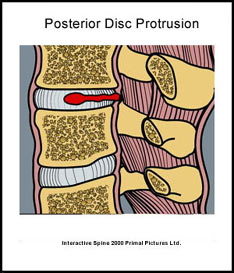In order to understand this topic it is important to understand the basic anatomy of the spine. Please review the section on basic spine anatomy before reading this section. To understand how the spine works, please review the section on the basic spine biomechanics.
What is a cervical disc herniation?
Most of the vertebrae (bones) in the neck and all of the vertebrae in the rest of the spine are separated by a structure called the “intervertebral disc”. These discs act as spacers between the vertebrae and they also function as shock absorbers. Each disc consists of a gel-like center called the “nucleus pulposis”, and a tough outer layer called the “annulus fibrosis”. A disc herniation (a.k.a. slipped disc, ruptured disc, torn disc) is the term used to describe an abnormality of the intervertebral disc in which the nucleus pulposis bulges out through the annulus fibrosis. In the neck the nucleus pulposis is relatively small and the disc is mostly made up of the annulus fibrosis so disc herniations in the neck are relatively rare when compared to disc herniations in the lower back.

What does a cervical disc herniation feel like?
People with a disc herniation often complain of neck pain. If the protruding disc puts pressure on one of the spinal nerves, the pain may spread to the area that is supplied by the nerve. Depending on which nerve is involved the pain often spreads to the shoulder, the shoulder blade, down the arm back or down into the hand. The pain is usually described as a “deep” or “sharp” pain that is aggravated certain neck positions.
How do cervical disc herniations occur?
Disc herniations can occur as a result of any sudden injury to the head or neck. Disc herniations can be seen in people who have been involved in a motor vehicle accident or who have been injured while participating in contact sports such as football or hockey.

Fo0bar, CC BY-SA 3.0 https://creativecommons.org/licenses/by-sa/3.0, via Wikimedia Commons
How is a cervical disc herniation diagnosed?
The first step in the diagnosis of a herniated disc is to obtain a good medical history and perform a physical examination. X-rays of the neck may help rule out degenerative disc disease (which is more common and can mimic the symptoms of a disc herniation) or other bone problems of the spine. An MRI is a very good test to determine if there is a disc herniation. The MRI can detect if there is pressure from the disc herniation on one of the spinal nerves. A CT scan (CAT scan) may also be helpful because it is better than an MRI at looking at the bones in the spine that may be putting pressure on the spinal nerves.
What is the treatment for a cervical disc herniation?
Treatment for a disc herniation should involve a team approach. Most types of treatment for a disc herniation work best when started early. For this reason establishing a correct diagnosis is important. Available treatments include physiotherapy to learn proper movement patterns, education on activity modification, proper posture, and exercises. Physiotherapy may also include traction, manual treatments, and modalities such as gentle electrical currents and heat or ice to help with pain.
Medications may also be an important part of the initial treatment. Doctors may prescribe anti-inflammatory medications, pain medications and/or muscle relaxants. In some cases surgery is required to relieve the pressure the herniated disc is placing on the spinal nerve.
After someone recovers from a disc herniation it is important to maintain a healthy neck by maintaining proper posture, and exercises to maintain strong neck muscles. These measures will help decrease the chance of another disc herniation. Doctors and Physical Therapists that deal with people with degenerative disc disease can help outline an individualized treatment and recovery program.
What other information is available on cervical disc herniations?
Back Pain Info / Neck Pain Info’s links section has additional information on this topic. Links have been provided to other websites as well as online medical journals. Visit Joint Pain Info. Com for information on other joint injuries and problems.
